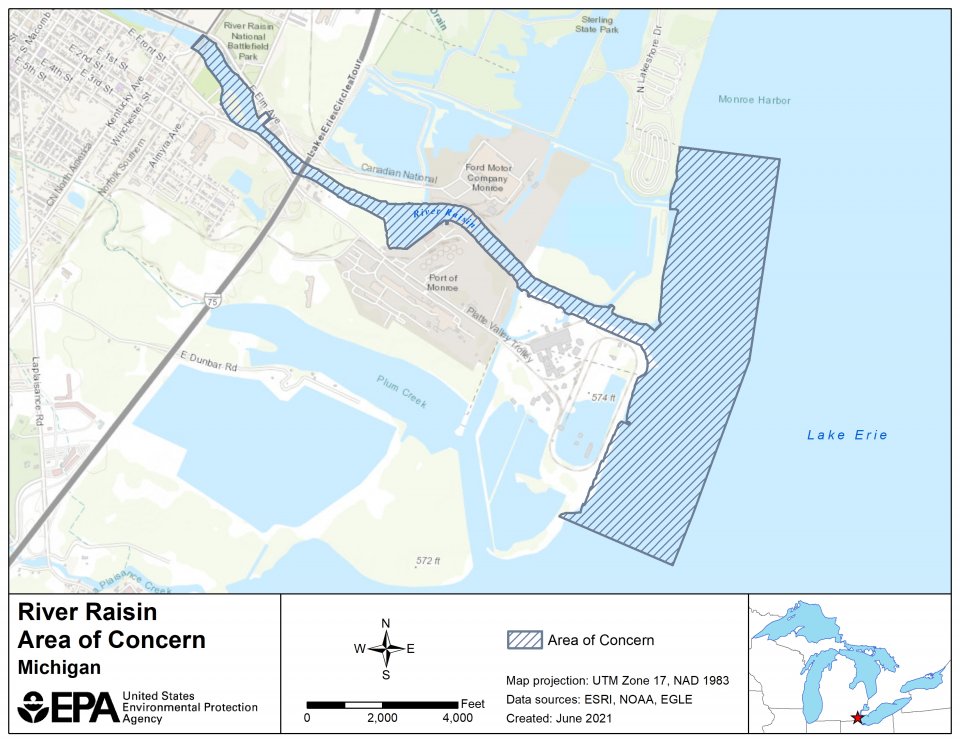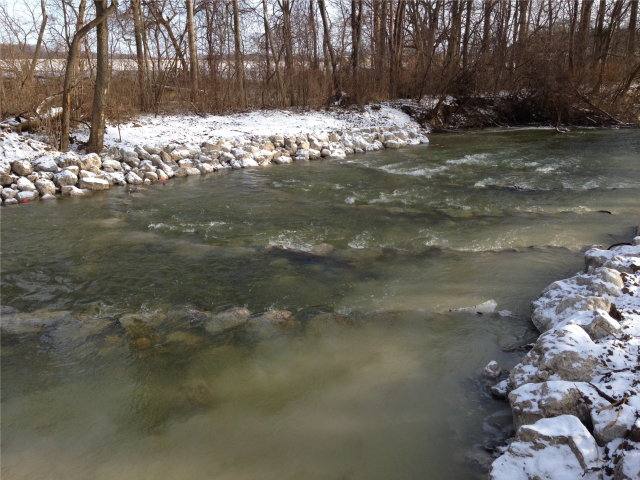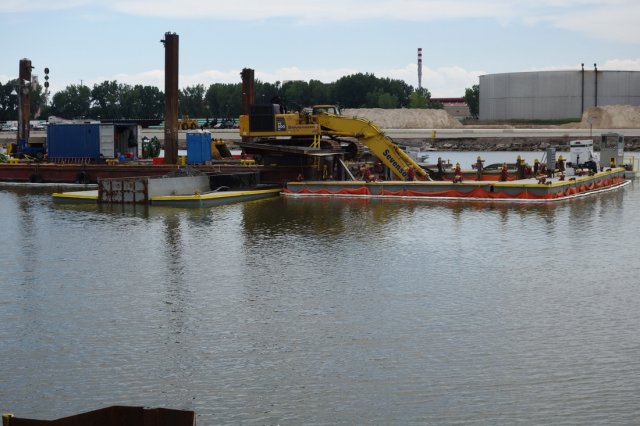River Raisin AOC
Meaghan Kern
(Kern.Meaghan@epa.gov)
312-353-5784
Overview
The River Raisin was designated an Area of Concern (AOC) under the 1987 Great Lakes Water Quality Agreement. Historical discharges of oils, grease, heavy metals and polychlorinated biphenyls (PCBs) from industrial facilities caused significant environmental degradation warranting the AOC designation. Historical steel, motor, aluminum and, paper mills, local landfill discharges, and agricultural runoff have all contributed to the degradation of this AOC. The River Raisin AOC is located in the southeast portion of Michigan's lower peninsula in Monroe County. The boundary of the River Raisin AOC is the lower (2.6 miles) portion of the River Raisin, downstream from Dam No. 6 at Winchester Bridge in the City of Monroe. It extends one-half mile into Lake Erie following the Federal Navigation Channel and along the nearshore zone of Lake Erie both north and south, for one mile and extending out into Lake Erie for ½ mile.
Beneficial Use Impairments
Beneficial Use Impairments, or BUIs, are designations given by the International Joint Commission for an AOC. They recognize various examples of significant environmental degradation. As restoration and cleanup projects make progress, monitoring is conducted at the site to determine the level of recovery in environmental health. If sufficient recovery is reached, BUIs can be designated as “removed.”
In close collaboration with the River Raisin Public Advisory Council (PAC), state, local and federal partners including the U.S. Environmental Protection Agency (EPA), five BUIs have been removed. Only four BUIs are left to be removed from this AOC. See the following list below. Once all BUIs are removed, the process of delisting the AOC can begin.
- Restrictions on Fish and Wildlife Consumption
- Eutrophication or Undesirable Algae – Removed September 2013
- Degradation of Fish and Wildlife Populations – Removed August 2015
- Beach Closings – Removed September 2013
- Degradation of Aesthetics – Removed April 2012
- Bird or Animal Deformities or Reproduction Problems
- Degradation of Benthos
- Restrictions on Dredging Activities
- Loss of Fish and Wildlife Habitat – Removed August 2015
Remediation and Restoration Work
All remediation and restoration projects or management actions are complete in the River Raisin AOC. Monitoring will continue in order to address the remaining four BUIs and delist the AOC. Projects to restore the AOC included work to reduce erosion to an in-river island, create and restore marsh and prairie habitat, remove invasive plant species, enhance fish passage to the river, and remove contamination from the food chain. These projects have provided habitat for fish, waterfowl, turtles and other wildlife. While not all BUIs have been removed, we are seeing positive results. Bird populations are starting to recover; bald eagle and osprey have been seen nesting in the area and migrating shorebirds use the restored coastal marsh in Sterling State Park.
Remediation and Restoration Projects for the River Raisin AOC
Habitat Restoration Project Highlight: Fish Passage Restoration Project
The River Raisin, known as “Nummasepee” or River of Sturgeon by Native Americans, was previously choked at the mouth by 8 different dams that prevented fish from migrating upstream from the Great Lakes. The River Raisin Fish Passage Projects reconnected Lake Erie to the lower 23 miles of the river. This has allowed fish to travel up the river for spawning and expanded recreational access to the river. The project was conducted in two phases. In Phase one, two low head dams were removed and rock arch ramps installed around two additional dams. Rock arch ramps help to emulate a natural river system by maintaining healthy depth and velocity conditions during low flow events and withstanding higher water levels without structural damage to the dams. Fish are easily able to pass these structures. Afterwards, Phase two installed two additional rock arch ramps; constructed a small channel for fish passage around another dam; and enhanced another fish passage channel.
These projects were necessary to remove both the Loss of Fish and Wildlife Habitat and Degradation of Fish and Wildlife Populations BUIs. Fish are now using the new fish passage structures to access a longer stretch of the river. Scientists have also noted the presence of gizzard shad and blackside dace—migratory fish species never before encountered at this location. Without barriers along the river, residents are also taking advantage of kayaking, canoeing, and fishing opportunities.
Project Highlight: River Raisin Sediment Remediation
Two large Great Lakes Legacy Act Projects removed 132,400 cubic yards of sediment contaminated with PCBs. The first project occurred in 2012-2013 and removed 106,000 CY. The second project took place in 2016 and addressed a 1.45-acre area where material affected by PCBs was dredged and capped. The projects were located northeast of the Port of Monroe turning basin. During the first project, the sediment was disposed of in the Sterling State Park Confined Disposal Facility (CDF). To use this facility, USEPA had to first remove an equal volume of sediment from the CDF to maintain its capacity for future navigation channel maintenance. For the second project in 2016, an off-site disposal facility was used, and material was disposed of at a separate disposal facility due to a high level of PCB contamination. These projects cost a total of $44.2 million and was cost shared between EPA, Michigan Department of Environment, Great Lakes, and Energy (EGLE), and Ford Motor Company.
EPA worked closely with project partners, the Ford Motor Company and EGLE, to complete the sediment remediation projects. These projects are necessary to remove the following BUIs, which have not yet been removed.
- Restrictions on Fish and Wildlife Consumption
- Bird and Animal Deformities or Reproduction Problems
- Restrictions on Dredging Activities
- Degradation of Benthos
Monitoring will determine when these BUIs can be removed and assure the sediment remediation is effective long-term.
Documents
Documents related to restoring the River Raisin AOC
Partners
The following links exit the site
- National Oceanic and Atmospheric Administration
- U.S. Army Corps of Engineers
- U.S. Geological Survey
- Ford Motor Company
- Illinois-Indiana Sea Grant
- Michigan Department of Environment, Great Lakes, and Energy
- Monroe Port Authority
- Michigan Department of Health and Human Services
- River Raisin Public Advisory Council
- River Raisin Commission on the Environment and Water Quality
- River Raisin Institute
- River Raisin Watershed Council





